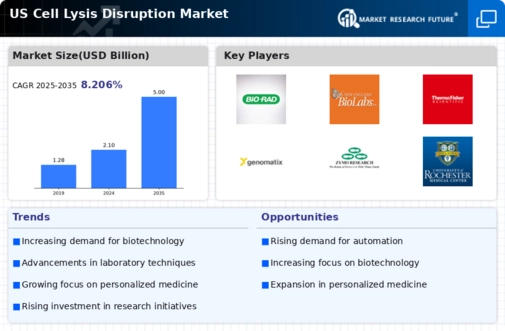Growing Focus on Personalized Medicine
The shift towards personalized medicine is significantly impacting the cell lysis-disruption market. As healthcare moves towards tailored therapies, the need for precise and efficient cell lysis methods becomes increasingly important. Personalized medicine relies on the analysis of individual patient cells, necessitating effective disruption techniques to obtain accurate genomic and proteomic data. The US market for personalized medicine is expected to exceed $200 billion by 2026, highlighting the potential for growth in related fields, including cell lysis technologies. This trend suggests that advancements in cell lysis-disruption methods will be essential for the development of targeted therapies, thereby driving demand within the market. As researchers and clinicians seek to optimize treatment outcomes, the integration of innovative lysis techniques will likely become a focal point in the ongoing evolution of personalized healthcare.
Increased Investment in Biomanufacturing
The cell lysis-disruption market is benefiting from a surge in investment in biomanufacturing processes. As the demand for biologics and biosimilars continues to rise, manufacturers are increasingly focusing on optimizing production methods, including cell lysis. In 2025, the biomanufacturing market in the US is projected to reach $150 billion, with a significant portion allocated to improving cell disruption techniques. This investment is driven by the need for higher yields and cost-effective production processes. Consequently, advancements in lysis technologies are likely to emerge, enhancing the efficiency of biomanufacturing operations. The emphasis on scalable and reproducible methods will further propel the growth of the cell lysis-disruption market, as companies strive to meet the increasing demand for biologics while maintaining quality and compliance.
Emerging Applications in Synthetic Biology
The rise of synthetic biology is creating new opportunities for the cell lysis-disruption market. As researchers explore the engineering of biological systems for various applications, the need for effective cell lysis methods becomes critical. Synthetic biology encompasses a range of fields, including biofuels, pharmaceuticals, and environmental applications, all of which require efficient cell disruption techniques to extract valuable biomolecules. The US synthetic biology market is projected to reach $40 billion by 2027, suggesting a growing demand for innovative lysis solutions. This trend indicates that advancements in cell lysis technologies will be essential for supporting the diverse applications of synthetic biology. As the field continues to evolve, the cell lysis-disruption market is likely to experience significant growth driven by the need for tailored lysis methods that meet the specific requirements of synthetic biology projects.
Regulatory Support for Biotech Innovations
Regulatory frameworks in the US are increasingly supportive of innovations in biotechnology, which positively influences the cell lysis-disruption market. Agencies such as the FDA are streamlining approval processes for new biotechnological products, encouraging the development of advanced cell lysis techniques. This regulatory environment fosters innovation, allowing companies to bring novel lysis solutions to market more efficiently. As the biotechnology sector continues to expand, the demand for compliant and effective cell disruption methods is likely to grow. The potential for expedited approvals and supportive policies may lead to increased investment in research and development, further driving advancements in the cell lysis-disruption market. This trend indicates a favorable landscape for companies focused on developing cutting-edge lysis technologies that align with regulatory standards.
Rising Research Activities in Biotechnology
The cell lysis-disruption market is experiencing growth due to an increase in research activities within the biotechnology sector. As institutions and companies invest heavily in R&D, the demand for effective cell lysis techniques rises. This is particularly evident in the development of novel therapeutics and vaccines, where cell lysis plays a crucial role in extracting cellular components. In 2025, the US biotechnology sector is projected to reach a market value of approximately $300 billion., indicating a robust environment for cell lysis technologies. The need for efficient and reliable cell disruption methods is paramount, as researchers seek to enhance the yield and purity of biomolecules. Consequently, this trend is likely to drive innovation and investment in the cell lysis-disruption market, fostering advancements in methodologies and equipment.





















Leave a Comment